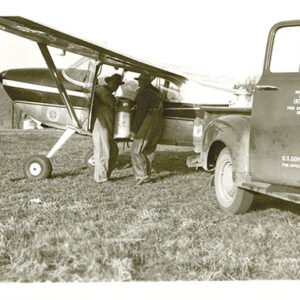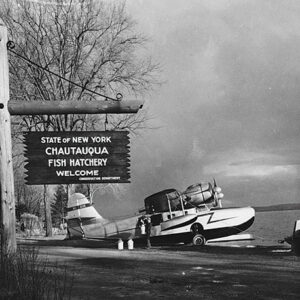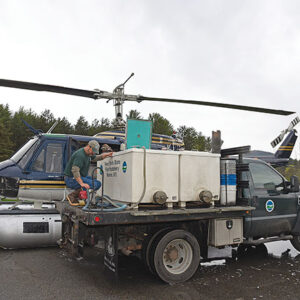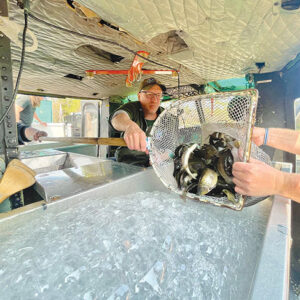
Features
Fish handling
Hatchery Operations
Restocking
It’s raining fish!
U.S. aerial stocking programs show nerve and know-how.
June 14, 2023 By Lynn Fantom
 New York State helicopters used for aerial stocking are part of a consolidated aviation unit with duties that include transporting the state’s governor. (Photo: NYSDEC)
New York State helicopters used for aerial stocking are part of a consolidated aviation unit with duties that include transporting the state’s governor. (Photo: NYSDEC) A decade ago Ted Hallows, hatchery supervisor in Kamas, Utah, first attached a GoPro camera to the bottom of a plane to show fish raining into a Utah lake below. Since then, as one Tweeter said, these videos have become “famous.”
Millions have viewed them on social media, amazed by the novelty of aerial fish stocking and calling the work “a dream job.” But no one appreciates the expertise of Utah’s hatchery professionals – and those like them around the U.S. – more than the avid anglers whose reverence for fishing in remote lakes and streams is almost religious.
Over decades, hatcheries have honed skills in fish handling and aerial delivery in Alaska, Colorado, Maine, Minnesota, New Hampshire, New York, Oregon, Utah, Vermont, and Wyoming. How the fish are flown to their destinations depends on the locale. Operations are technical, efficient, and sometimes very high risk. “We’ve come back to the airport and had tree branches stuck in the tires,” says Hallows.
Destination: Utah
Utah is known for trout fishing in high mountain lakes. In the northeastern part of the state, mountains over 13,500 feet boast some 2,000 lakes. Attracting passionate anglers in the south is an 11,000-foot peak, with heavy forests and views of Utah’s desert palette.
“It’s amazing to me how many people will hike to these lakes,” which might be 15 miles (24.1 km) from the nearest road, says Travis Dees, the assistant supervisor at the Kamas hatchery, part of the Utah Division of Wildlife Resources.
Not only are these lakes inaccessible by vehicles but the air is so thin that helicopters can’t get the lift they need to fly there efficiently and safely. And with the cliffs and tall trees surrounding lakes, planes must keep 50 to 150 feet above the water.
“For aerial stocking, five or six different hatcheries provide different fish that will meet what different areas need at different times of year,” says Hallows. They include brook trout, Arctic grayling, tiger trout, splake, and golden trout when available. To protect the native cutthroat species, the majority of what’s stocked is triploid.
The aerial stocking of 400-450 lakes statewide occurs every year in late June and then again in September/October. The program, which started in 1956, is funded almost exclusively through fishing license sales and is primarily to support recreation.
The Division of Wildlife Resources owns two Cessna 185 Skywagons, the single-engine aircraft prized for being able to lift more than its own weight. Like the bush planes that carry backpackers into the Arctic, these planes can carry up to 10,000 trout fingerlings at a time.
“We have our own pilots who are skilled in low-level flying that’s very high risk,” says Hallows. “They’re flying at 12 to 13,000 feet where the air’s thin. It’s hard on the plane to get lift and/or power to pull out.” But these pilots have experience in the bush, crop dusting, and pipeline surveillance.
Hallows estimates he has made about 800 flights during his 39-year career. “We’ve had to dump some tanks of water places just to get out of spots so we don’t crash into the hillsides. It gets pretty exciting sometimes,” he adds.
In addition to seeing wildlife like moose, deer, and mountain lions from the air, they also sometimes see people. “We’ve dumped fish on them float-tubing in the middle of lakes – covered ‘em with fish,” Hallows says.
Handle with care
During aerial stocking, the pilot maneuvers the plane as the co-pilot releases its stock of fingerlings through a hatch door. The fish are not hurt because, at one to three inches, they are so small the air slows their drop. The survival rate, cited as 95 per cent by the wildlife division, is higher than ground methods of stocking.
But even before the drop, a lot of special handling occurs, starting with loading the fish on to trucks early in the morning and then driving to the airport 20 miles away. Over the years, the team has streamlined loading operations at the plane which, in place of a backseat, holds a custom-built tank with seven compartments to stock seven lakes on each trip.
The hatchery professionals first load the water onto the plane and pre-measure fish to minimize stress. They know how many pounds of fish can exist comfortably in the small compartments and carefully manipulate growth to keep them small – under three inches – for both the plane trip and the ultimate drop.
The fish are not fed the day before so they won’t defecate in the tank and raise ammonia levels. Because they are not metabolizing food, they use less oxygen. Plus, they are hungry and active when they hit the lakes.
Hallows keeps the hauling water very cold, around 42°F (5.56°C), to hold more oxygen. During the flight, the co-pilot also monitors the performance of air stones in the tanks, which provide oxygen and circulate air by producing tiny bubbles.
“We can do between 50 and 60 lakes every morning before the wind blows us off,” says Hallows.
When in Rome, New York
Because the highest peak among the Adirondacks’ 46 mountains is 5,344 feet – modest by Western standards – New York State’s aerial stocking program can use helicopters. In fact, they may be the same ones transporting the governor around the state, which is large and rural in many places.
Like in Utah, aerial stocking garners enthusiasm in New York where the brook trout is the state fish. The Department of Environmental Conservation (DEC) air delivers brook, brown, and rainbow trout, as well as some landlocked salmon and round whitefish (endangered in New York), according to Albany-based fisheries biologist Jim Daley, who oversees the state’s 12 hatcheries. One of the largest is the Rome Fish Hatchery, a cold water growout facility in central New York State that produces the lion’s share of trout for aerial stocking.
In the spring, yearlings are carried by helicopter to remote stretches of river and bigger ponds for the “put and take” fishery. In the fall, when airplanes are also contracted for stocking, fingerlings “of four inches or so” are stocked for “put, grow, and take.” Most of these are Temiscamie hybrids, a cross between a domestic brook trout and a wild Canadian strain, which survive better in the more acidic waters of the Adirondacks.
Pontoons are a feature of helicopters used by the DEC. If a lot of fish are going into a bigger lake or a pond, the pilot will set down on the water. But for a small number, stocking is done from 15 to 20 feet.
Aeration in the helicopter is a physical agitator aerator that whips the water around, mixing oxygen in with it. On the airplane, oxygen is used.
Although helicopters are more expensive, they have about 50 per cent more capacity than the airplanes. Airplane stocking is “a little more time consuming for not as many fish,” says Rome hatchery manager Steve Grabowski. Because helicopters can hover closer to the water, fish survival is also higher. According to a 2020 PBS report, Minnesota hatcheries went from 85 per cent survival with plane stocking to 100 per cent after adopting helicopters.
The DEC has published a YouTube video that shows what goes on inside a helicopter. Midway along each side are two long, narrow tanks. A hatchery professional sits between them and nets fish into a chute for the final stage of delivery.
Stepping back, Grabowski says, “Logistics is huge.” A 24-year veteran of the hatchery, he has devised a system that efficiently maps a helicopter’s flight among ponds with a schedule of how much weight is to be stocked in each. Nets marked with poundage are key. “It’s quicker and better for the fish. Plus, less time, less money,” Grabowski says. It’s no surprise that he studied electrical engineering, while majoring in aquatic science in college.
Both Daley and Grabowski emphasize the value of building a good rapport with pilots and staff, who must be flexible during stocking season when weather and mechanical issues can cause delays. “It can be tough. People get there at 5 a.m. to load trucks and travel over to the landing zone. Then things get cancelled, and it’s back to the hatchery with trucks full of fish,” says Daley.
But on good days when they’re waiting for a helicopter to complete its delivery, Grabowski has a football or Frisbee to throw around. He’s been known to buy ice cream for the team on the way back to the hatchery. Staff motivation and training are never to be discounted among hatchery managers. Grabowski mentions he has four new staffers this year.
For operations like aerial stocking, where there isn’t enough demand for equipment to be mass produced, management can also require ingenuity in adapting nets, tanks, and other equipment. “We come up with a better way, and we build it,” says Grabowski.
Documentation is a best practice in the corporate world, but Grabowski applies it to his work. Every year he logs fish per water body, stocking routes sequences, and special notes, like when a pilot reports overgrown trees at a river that will require a work-around. “It makes it easier for me, for the pilots, and if somebody had to take over,” he says.
Grabowski wrote a book about deer hunting in the Adirondacks, but it sounds as if he could write one about hatchery management, too.
Print this page
Advertisement
- Sanctions have not derailed the Russian aquaculture development
- Rhode Island university offers free online training









